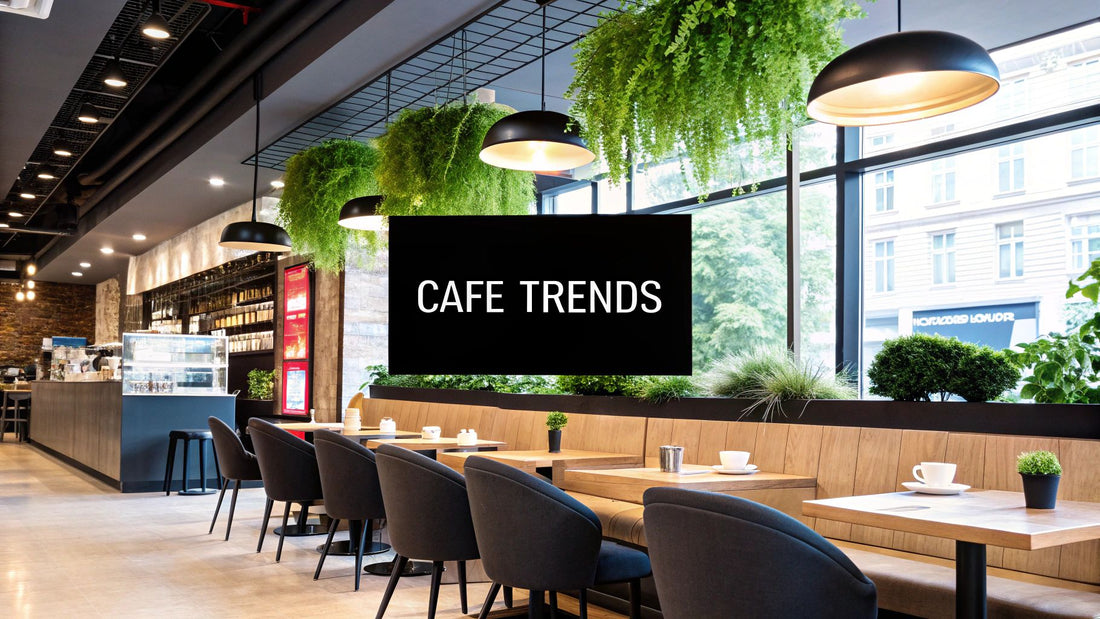
Top Coffee Shop Design Ideas for 2025
Share
Crafting an Atmosphere: Why Your Coffee Shop's Design is as Crucial as Your Beans
The aroma of freshly ground coffee, the rich flavour of a perfectly pulled espresso, the velvety texture of steamed milk – these are the foundations of any great coffee shop. But in the UK’s bustling and sophisticated speciality coffee market, sensory excellence alone isn't enough to guarantee success. Your customers aren't just buying a drink; they are seeking an experience, a moment of comfort, a 'third place' between home and work where they can connect, relax, or focus. This is where your design comes into play. The right atmosphere can transform a simple coffee run into a memorable ritual, turning first-time visitors into loyal regulars.
A thoughtfully designed space does more than just look good. It communicates your brand's story, enhances operational efficiency for your baristas, and creates a welcoming environment that encourages customers to stay longer and spend more. It’s a powerful, non-verbal conversation with everyone who walks through your door, telling them exactly who you are and what you stand for before they even reach the counter.
This comprehensive guide is built to provide you with a wealth of actionable coffee shop design ideas, moving beyond generic advice to offer specific, practical inspiration. We will explore ten distinct aesthetic and functional concepts, from the raw authenticity of industrial interiors to the calming influence of biophilic living walls and the community-focused comfort of a 'living room' layout. Whether you're planning a new venture, considering a refurbishment, or simply looking for ways to refresh your current space, this curated collection will provide the creative spark and practical steps needed to craft an environment as remarkable as your coffee.
1. Industrial Design Style
The industrial aesthetic is one of the most enduring and impactful coffee shop design ideas, drawing its soul from the raw, functional beauty of old factories and urban warehouses. This style champions authenticity, celebrating the structural bones of a building rather than concealing them. It creates a space that feels both historic and contemporary, offering a genuine, unpretentious backdrop for enjoying speciality coffee. Think exposed brickwork, visible steel beams, polished concrete floors, and unconcealed ducting.
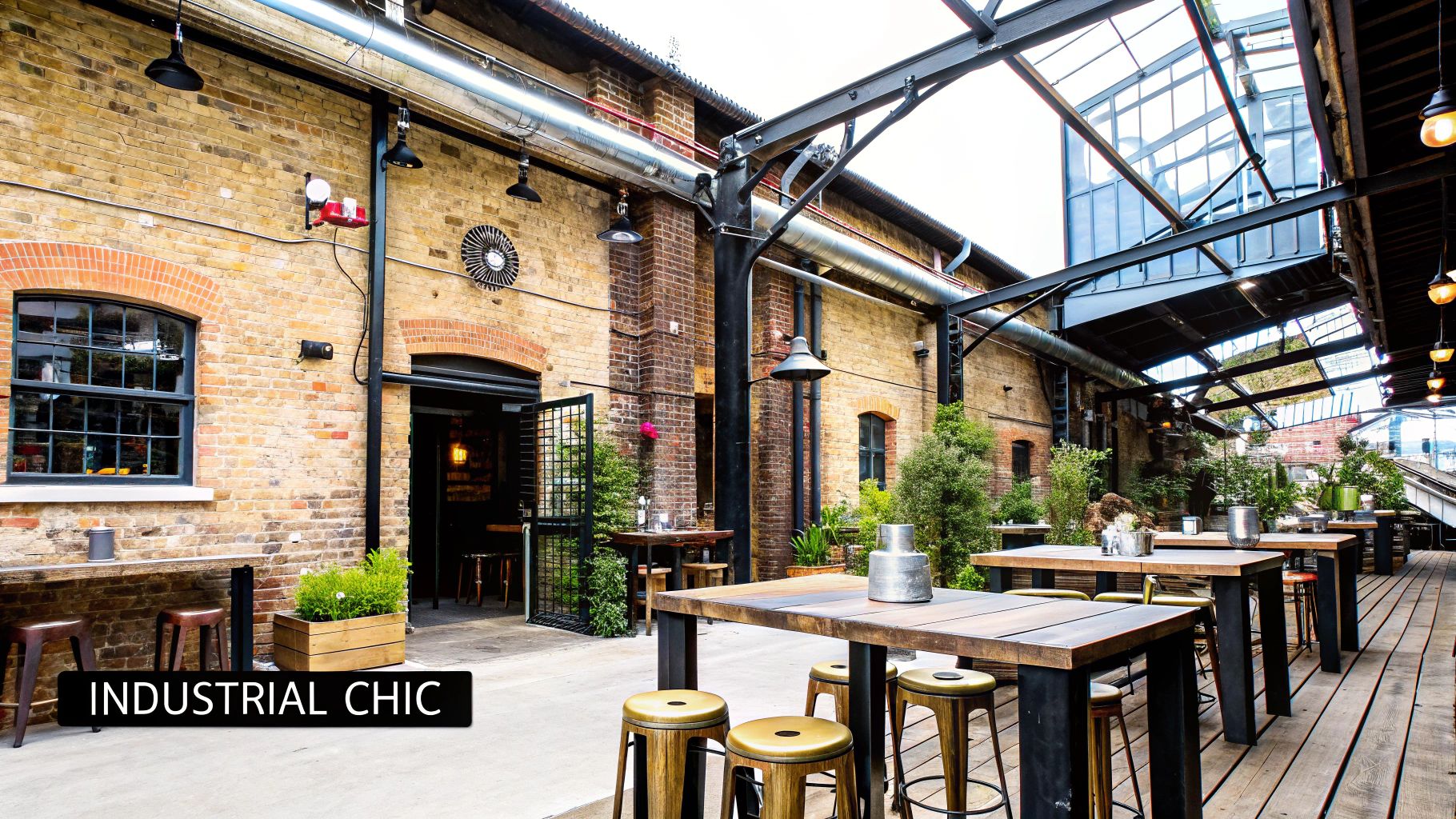
This approach has been masterfully executed by pioneering brands like London's Workshop Coffee, where the focus on transparency in coffee sourcing is mirrored by the honest, open-plan design of their spaces. The style connects with customers who appreciate craftsmanship and a no-fuss environment, allowing the quality of the coffee and the skill of the barista to take centre stage.
How to Implement an Industrial Vibe
Successfully creating an industrial feel is about achieving a careful balance between rugged materials and comforting elements. Without this harmony, the space can feel cold or uninviting.
- Soften the Edges: Counteract the harshness of metal and concrete with softer textures. Introduce leather-upholstered seating, woollen throws over armchairs, and plush cushions to create cosy nooks.
- Embrace Biophilic Design: Integrate large, leafy plants like Monsteras or Fiddle Leaf Figs. The vibrant green provides a natural, organic contrast to the man-made materials, breathing life and warmth into the environment.
- Manage Acoustics: Industrial spaces with hard surfaces can be noisy. Strategically place large, textured area rugs under seating areas to absorb sound, define different zones, and add a layer of visual warmth.
- Honour Local Heritage: Research the local area’s industrial past. Could you incorporate reclaimed materials from a local mill or feature large-scale historical photographs? This adds a unique, meaningful layer to your design story. For example, a coffee shop in a former textile mill in Manchester could use salvaged bobbins or loom parts as decorative features.
2. Scandinavian Minimalist Design
Scandinavian minimalist design is a powerful coffee shop design idea rooted in simplicity, functionality, and a deep connection to nature. This style creates a calm, uncluttered, and inviting atmosphere where customers can relax, focus, and appreciate the finer details of their coffee. It is defined by its use of light wood, clean lines, neutral colour palettes, and an abundance of natural light, offering an antidote to the chaos of modern life.
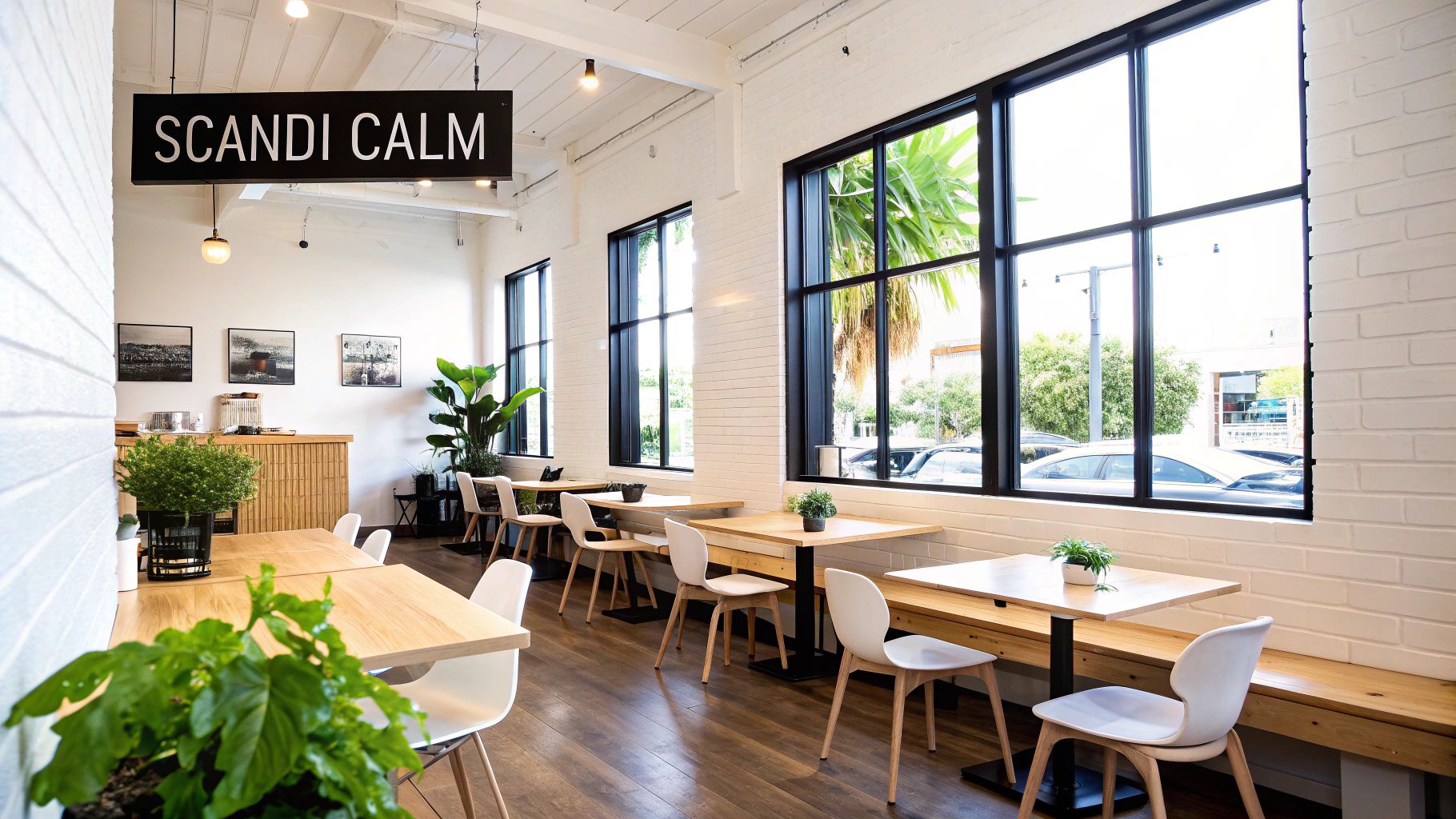
The ethos of this design perfectly complements the speciality coffee movement, where the focus is on quality, clarity, and thoughtful preparation. Pioneers of this aesthetic, such as La Cabra Coffee in Denmark, demonstrate how a minimalist environment can elevate the sensory experience of coffee. This clean, serene backdrop allows the vibrant colours and complex aromas of the coffee to become the main event, creating a space that feels both premium and welcoming.
How to Implement a Scandinavian Vibe
Achieving a successful Scandinavian look is about more than just white walls and pale wood; it's about curating a feeling of contentment and purposeful simplicity, often described by the Danish concept of 'hygge'.
- Embrace 'Hygge': Cultivate a sense of cosiness and comfort. Use soft, warm lighting from low-hanging pendants, place minimalist candles on tables, and drape soft woollen blankets over the backs of simple, well-designed chairs.
- Prioritise Natural Textures: Layer natural materials to add warmth and visual interest. Combine light woods like birch or ash for furniture and counters with slate or stone elements. Tactile linen cushions and ceramic tableware complete the look.
- Incorporate Biophilic Elements: Bring the outdoors in with carefully chosen greenery. Opt for simple, elegant plants in modern planters, like a Snake Plant or a single fiddle-leaf fig, to add a touch of organic life without creating clutter.
- Focus on Functional Furniture: Every piece should have a purpose. Choose well-crafted furniture with clean lines and clever, space-saving features. Think of benches with built-in storage or modular tables that can be easily reconfigured.
- Maintain Lighting Consistency: Ensure all artificial light sources have a consistent, warm colour temperature (around 2700K). This creates a cohesive and tranquil ambience, especially important during the UK's grey winter days.
3. Biophilic Design with Living Walls
Biophilic design is a powerful coffee shop design idea that intentionally weaves nature into the built environment, creating a restorative and invigorating atmosphere. It moves beyond simply placing a few potted plants on a windowsill; it’s a holistic approach that uses living walls, natural materials, and organic patterns to forge a deep connection between customers and the natural world. This philosophy is rooted in our innate human tendency to seek out nature, resulting in spaces that feel calming, fresh, and vibrant.
This trend has been embraced by forward-thinking brands that understand the value of wellbeing. The concept aligns perfectly with the speciality coffee ethos of natural products and mindful consumption, enhancing the customer experience by creating a tranquil escape from the urban hustle. A stunning living wall not only acts as a breathtaking centrepiece but also improves air quality and provides a memorable, Instagram-worthy backdrop that patrons will want to share.
How to Implement a Biophilic Vibe
A successful biophilic interior feels effortlessly natural, but it requires careful planning to thrive. The goal is to create a seamless integration of nature that enhances comfort and sensory experience.
- Plan for Plant Care: A living wall is a long-term commitment. Choose low-maintenance, air-purifying plants suited to UK indoor conditions, such as peace lilies, ferns, or pothos. Ensure a professional-grade irrigation and drainage system is installed from the outset to prevent issues and simplify upkeep.
- Maximise Natural Light: Position your living wall and other key plant installations where they can receive adequate natural light. If your space has limited sunlight, invest in high-quality, full-spectrum LED grow lights that can be integrated into your overall lighting scheme.
- Incorporate Natural Materials: Extend the biophilic theme beyond plants. Use materials like reclaimed wood for tables, slate for countertops, and bamboo for flooring. Introduce textures like cork, stone, and rattan in furniture and decor to build a layered, organic environment.
- Consult the Professionals: Partner with a specialist UK-based landscape architect or interior plant designer. They can help you select the right species for your specific light conditions and air quality goals, design a sustainable system, and plan for seasonal plant rotation to keep the space looking fresh all year round.
4. Vintage Retro Aesthetic
The vintage retro aesthetic is a powerful coffee shop design idea that transports customers to a different era, creating an atmosphere of nostalgia, comfort, and charm. This style draws inspiration from specific decades, most notably the 1950s, 60s, and 70s, utilising period-specific colour palettes, furniture forms, and decorative motifs. It crafts a space that feels both characterful and reassuringly familiar, offering a cosy haven that encourages guests to linger and connect. Think curved formica tabletops, vinyl-upholstered seating, geometric patterns, and warm, earthy colour schemes.
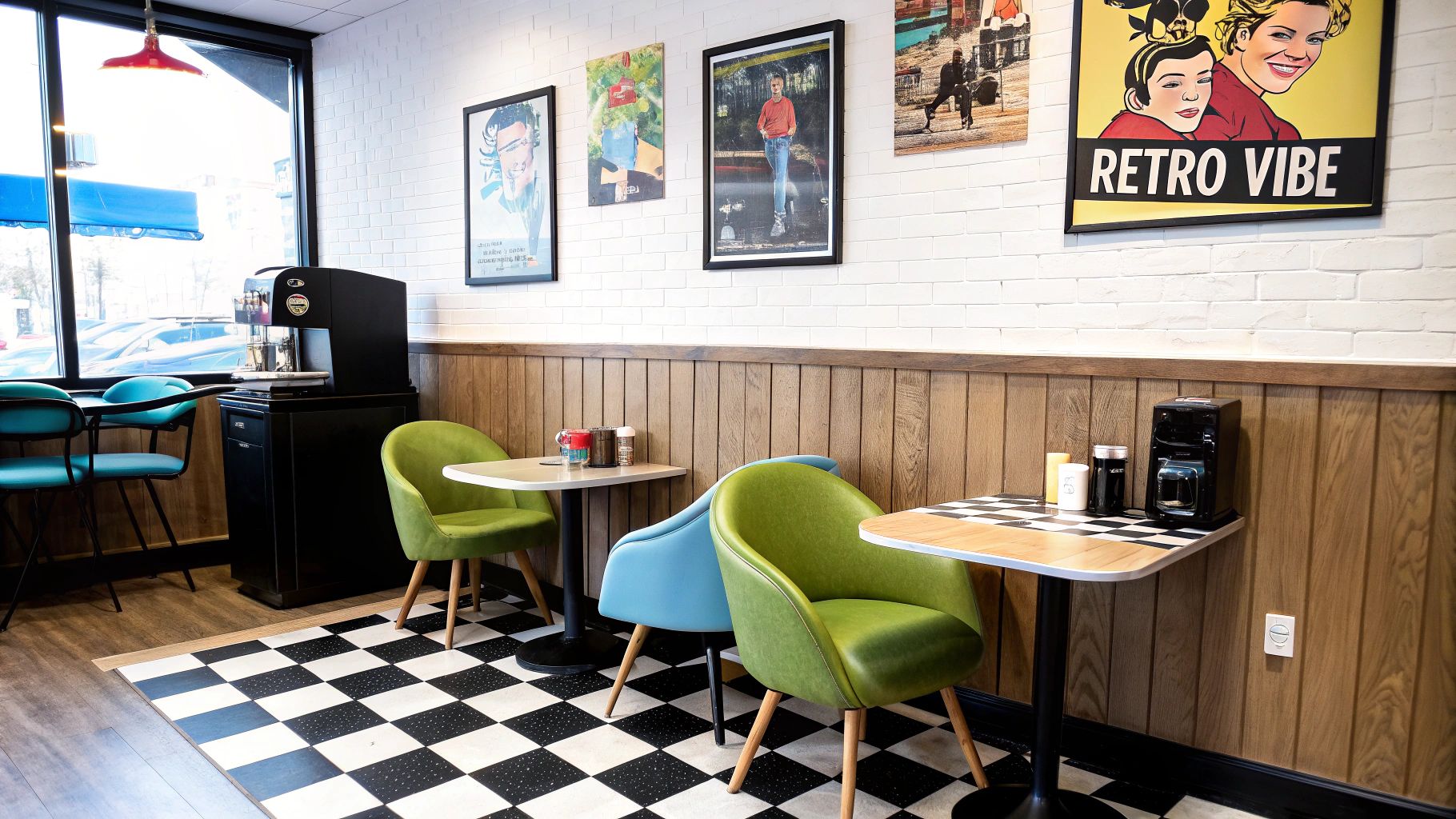
This design approach has seen a major revival, partly fuelled by the popularity of mid-century modern design. It connects deeply with a customer base that values authenticity and personality in its third space. A retro theme allows the coffee shop to stand out in a crowded market, offering a unique, memorable experience where the environment is as much a part of the product as the meticulously brewed flat white.
How to Implement a Vintage Retro Vibe
Creating an authentic retro atmosphere is about committing to a theme without it becoming a pastiche. The key is blending nostalgic elements with modern functionality and comfort to ensure the space is both stylish and practical for today's coffee lover.
- Commit to a Decade: Choose a specific era and stick with it for a cohesive design. A 1950s aesthetic with its chrome and pastel colours is very different from a 1970s lounge with its orange and brown tones. Look to British design movements for specific inspiration.
- Invest in Statement Pieces: Source a few high-quality, authentic vintage or reproduction furniture items to act as focal points. An original G-Plan sideboard used as a condiment station or a set of Ercol-style dining chairs can anchor the entire design scheme. UK-based antique fairs and online marketplaces are excellent resources.
- Balance with Modern Comforts: While authenticity is key, ensure your space meets modern expectations. Integrate discreet power outlets for laptops, provide reliable Wi-Fi, and make sure vintage-style seating is genuinely comfortable for customers staying for more than a few minutes.
- Curate a Multi-sensory Experience: Enhance the visual theme with period-appropriate music from British artists of the era. Consider details like vintage-style crockery, staff aprons, and menu designs to fully immerse your customers in the chosen era. For more inspiration, you can explore various interior living styles like Bohemian, Retro, and Rural to see how different elements can be combined.
5. Community Living Room Concept
The community living room concept reimagines the coffee shop as a second home, a welcoming hub where patrons can settle in, connect, and stay a while. This approach moves beyond purely transactional service, creating a comfortable, residential-style space designed for lingering. It’s one of the most powerful coffee shop design ideas for fostering loyalty and building a genuine neighbourhood feel, transforming your café into a cornerstone of the local community.
This design philosophy is about making people feel truly at ease. Think cosy armchairs you can sink into, shared tables that encourage conversation, overflowing bookshelves, and perhaps a selection of board games. It has been brilliantly adopted by independent bookstore-cafés and community-focused spots that thrive on creating a space for social interaction and relaxation, making them particularly beloved in university towns and close-knit residential areas across the UK.
How to Implement a Community Living Room Vibe
Creating a successful living room feel requires a thoughtful blend of comfort, function, and a welcoming atmosphere. The goal is to make the space feel personal and inhabited, not staged.
- Create Distinct Zones: Design different areas for different needs. Establish quiet reading nooks with soft lighting, larger communal tables for group work or socialising, and comfortable sofa areas for relaxed chats. This zoning allows various customers to coexist harmoniously.
- Power Up and Connect: A key element of modern comfort is connectivity. Ensure there are plenty of accessible power outlets and robust, free WiFi. This is a non-negotiable for patrons who use the space to work, study, or simply browse.
- Curate a Homely Library: Stock bookshelves with a diverse and rotating selection of books, magazines, and even local zines. Encourage a book-swap system to foster interaction. Regularly updating the collection keeps it fresh and gives regulars a reason to browse.
- Manage the Ambience: Soft furnishings are your friend. Use rugs, upholstered furniture, curtains, and even wall tapestries to absorb sound and prevent the space from feeling cavernous or loud. A well-managed acoustic environment is crucial for comfort during longer stays.
6. Local Art Gallery Integration
Transforming your coffee shop into a dynamic cultural hub is a powerful design idea that builds deep community roots. By integrating a rotating local art gallery, your space becomes more than just a place for coffee; it evolves into a destination for creative discovery. This concept champions local talent, giving artists a platform while offering customers an ever-changing, visually stimulating environment that encourages repeat visits to see what’s new.
This approach creates a symbiotic relationship between the arts and coffee culture, appealing to customers who value creativity and local community support. A blank wall becomes a canvas, a quiet corner becomes a sculpture plinth, and the entire café feels alive with fresh energy. It's a design choice that reflects a commitment to the neighbourhood's cultural fabric, making your coffee shop a cornerstone of the local arts scene.
How to Implement an Art Gallery Concept
A successful gallery integration requires more than just hanging a few pictures. It demands a thoughtful, organised approach to curate a professional and seamless experience for both artists and customers.
- Establish Clear Curatorial Guidelines: Create a formal submission process and curatorial theme for each exhibition period. This ensures the artwork aligns with your brand's aesthetic and quality standards. Partnering with a local independent curator or an art school can bring professional expertise to the selection process.
- Invest in Professional Display Systems: Proper presentation is key. Install professional gallery-style track lighting that can be adjusted to highlight each piece effectively. Use a secure hanging system that is versatile for different art sizes and protects your walls from damage.
- Formalise Artist Partnerships: Draft clear, simple contracts for exhibiting artists. Outline the exhibition duration, responsibilities for installation and de-installation, and the commission structure for any sales made through the shop. A typical commission split in the UK art scene is around 70/30 in favour of the artist.
- Host Opening Receptions: Generate buzz and celebrate the artists by hosting launch events for each new exhibition. These receptions can attract new customers, create press opportunities, and solidify your café's reputation as a community arts venue. Offer a complimentary drink or a special menu item for the evening.
7. Rustic Farmhouse Style
The rustic farmhouse style offers a heartwarming and nostalgic escape, drawing its design inspiration from the simplicity and authenticity of country life. This aesthetic is all about creating a cosy, welcoming environment that feels like a home away from home. It champions natural materials, handcrafted details, and a sense of history, making it one of the most inviting coffee shop design ideas for community-focused spaces. Think reclaimed barn wood, mismatched vintage-style furniture, and warm, earthy colour palettes.
This style has gained widespread appeal, resonating deeply with customers who value comfort, community, and authenticity. It’s particularly effective in rural towns or suburban areas across the UK where it can connect with local heritage. The aesthetic creates a perfect backdrop for serving locally sourced cakes and artisan coffees, reinforcing a message of quality and traditional craftsmanship.
How to Implement a Rustic Farmhouse Vibe
Achieving an authentic farmhouse feel requires a delicate balance between rustic charm and modern functionality. The goal is to feel genuinely cosy, not cluttered or contrived.
- Embrace Natural and Reclaimed Materials: The foundation of this style is in its materials. For a truly authentic rustic farmhouse feel, consider incorporating elements like reclaimed wood for a rustic look, which can be used for countertops, feature walls, or shelving. Pair this with other natural textures like stone, jute, and linen.
- Balance with Modern Comfort: Avoid creating a space that feels like a museum. Blend rustic pieces with modern comforts, such as contemporary lighting fixtures or sleek, comfortable seating alongside a distressed wooden table. This contrast keeps the design fresh and functional for today's customer.
- Curate Authentic Décor: Source decorative items thoughtfully. Look for genuine vintage farm tools, antique mirrors, or ceramic jugs from local antique shops rather than mass-produced replicas. Incorporate local agricultural history through framed prints or maps to give your space a unique story.
- Thoughtful Use of Thematic Elements: While elements like mason jars or gingham patterns are hallmarks of the style, use them sparingly to avoid cliché. A few well-placed details will have more impact than an overwhelming theme. Focus on quality and authenticity to create a space that feels both genuine and professionally designed.
8. Multi-Zone Flexible Layout
A multi-zone flexible layout is a strategic coffee shop design idea that acknowledges the modern customer's varied needs. It moves beyond a one-size-fits-all approach by dividing the space into distinct areas, each tailored to a specific activity. This design caters to everyone from the remote worker seeking quiet focus to a group of friends catching up, transforming a single café into a versatile, community-focused hub. Think quiet work zones with ample plugs, communal tables for socialising, soft lounge seating for relaxing, and quick-service standing bars.
This concept, heavily influenced by modern co-working and library design, has been masterfully adopted by high-concept coffee spaces. For instance, the design philosophy of CitizenM's societyM spaces showcases how furniture, lighting, and partitions can create multiple functional 'rooms' within one open-plan area. This approach maximises the value of your square footage, ensuring the space is dynamic and appealing to different customer profiles throughout the entire day.
How to Implement a Multi-Zone Layout
Creating a successful multi-zone environment is about clear definition and thoughtful planning. Each zone must feel intentional without making the overall space feel disjointed.
- Define Zones with Visual Cues: Use furniture, flooring, and lighting to create clear boundaries. A large area rug and soft armchairs can define a lounge zone, while high-top tables and stools signal a more transient social area. Different paint colours or wall textures can also effectively demarcate spaces.
- Plan the Power Grid: Each zone has different technical needs. The "work zone" will require abundant, easily accessible plug sockets and USB ports at every seat. Social areas may need fewer, while lounge zones benefit from strategically placed sockets for occasional use.
- Manage the Soundscape: Acoustic separation is crucial. Use tall planters, bookshelves, or acoustic panelling to buffer sound between a quiet work zone and a bustling social area. Soft furnishings like rugs, curtains, and upholstered seating will absorb ambient noise and prevent the café from feeling cavernous or loud.
- Use Smart Signage: While visual cues are powerful, subtle signage can help guide customers. A simple, well-designed sign indicating a "Quiet Zone" or "Communal Table" removes ambiguity and helps customers find the space that best suits their needs, improving their overall experience.
9. Coffee Production Showcase Design
This immersive concept transforms your coffee shop into a theatre of production, placing the craft of coffee making at the very centre of the customer experience. A coffee production showcase design tears down the walls between the consumer and the artisan, revealing the journey from green bean to finished cup. It is one of the most powerful coffee shop design ideas for building brand trust and celebrating the skill involved in speciality coffee. Imagine the hum and aroma of an in-house roaster, the precision of a dedicated slow-brew bar, and educational displays that tell the story of each bean.
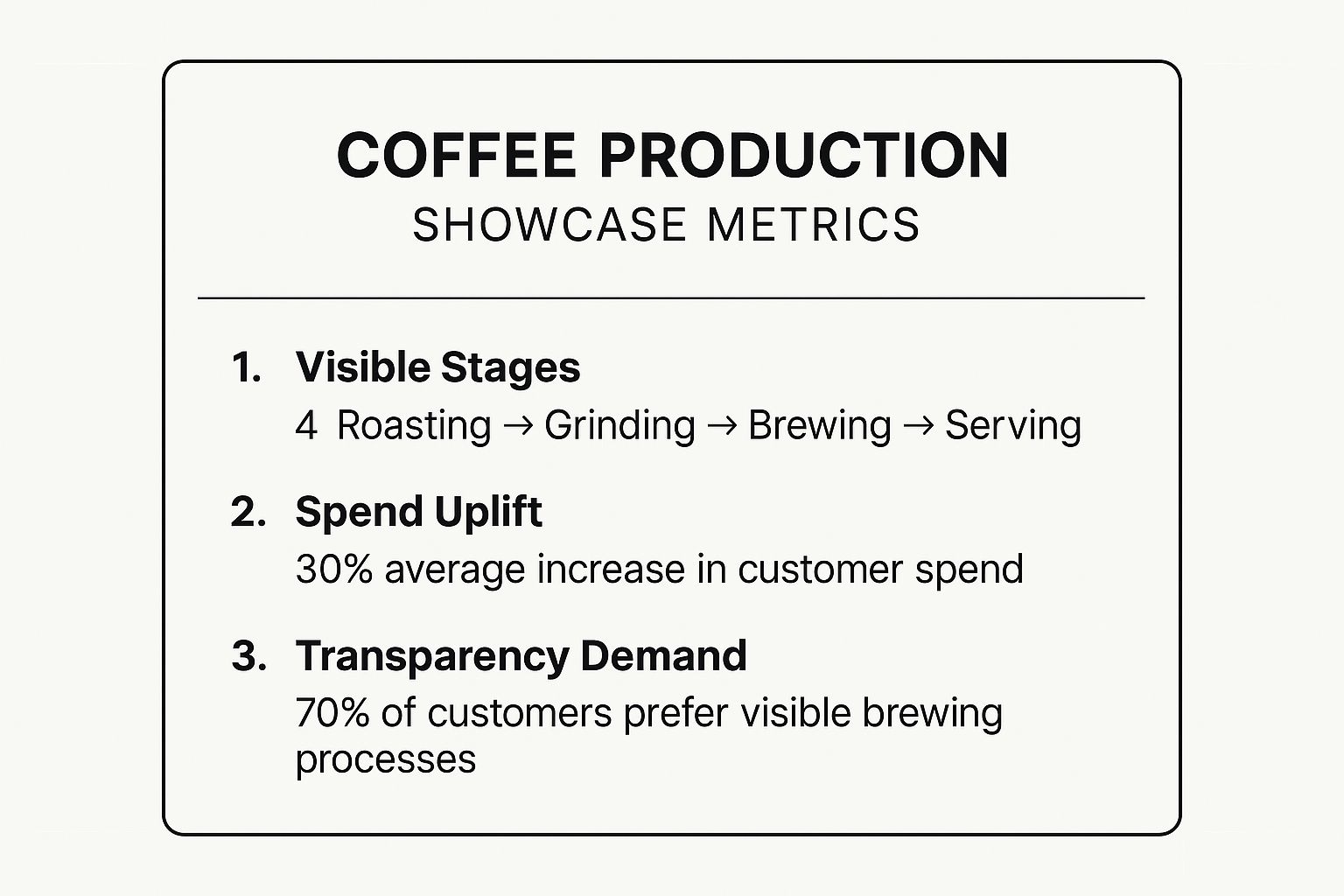
This transparent approach is a hallmark of the speciality coffee scene, with roastery-cafés across the UK adopting this model to connect with customers who crave authenticity and a deeper appreciation for their daily brew. It creates an educational and engaging atmosphere, demonstrating a serious commitment to the craft.
How to Implement a Production Showcase
Bringing the back-of-house operations into the spotlight requires careful planning, focusing on both the practicalities of production and the engagement of your audience.
- Create a Focal Point: Make your roaster or primary brewing station the undeniable star of the show. Position it for maximum visibility from the entrance and seating areas. Use strategic spot lighting to draw the eye and consider a low-profile counter to ensure an unobstructed view.
- Invest in Ventilation: An in-house roaster produces smoke and chaff, making a professional-grade ventilation and extraction system non-negotiable for UK health and safety compliance. This is crucial not only for safety and air quality but also for ensuring the captivating aroma of roasting coffee is pleasant, not overwhelming.
- Educate and Engage: Your team are the guides on this sensory journey. Train them to confidently explain the roasting process, discuss bean origins, and recommend different brewing methods. Simple, elegant signage, such as origin maps or flavour note cards next to grinders, can further enrich the experience.
- Schedule for Impact: Plan your roasting sessions during busy periods, like a Saturday morning or weekday lunchtimes. The activity, sound, and aroma create a dynamic and memorable atmosphere that acts as a powerful marketing tool, drawing in passers-by and delighting regulars.
10. Sustainable Eco-Friendly Design
An eco-friendly approach is more than just a trend; it's a powerful statement of values that resonates deeply with modern consumers. This design philosophy prioritises environmental responsibility, weaving sustainability into the very fabric of the coffee shop through reclaimed materials, energy-efficient systems, and a commitment to waste reduction. It creates a space that feels honest, purposeful, and aligned with the ethical sourcing story of speciality coffee, attracting customers who choose to support businesses that reflect their own principles.
This ethos is championed by forward-thinking brands that build their identity around conscious consumption. Think of London's certified B-Corp coffee shops or zero-waste cafes in Brighton, where the design choices actively support a circular economy. A sustainable design connects with a growing market of environmentally-aware customers, proving that exceptional coffee and a commitment to the planet can, and should, go hand-in-hand.
How to Implement a Sustainable Vibe
Creating an authentically eco-friendly space is about making conscious choices that are both visible to customers and integrated into your operations. It’s a holistic approach that goes beyond just using recycled napkins.
- Prioritise Reclaimed and Recycled Materials: Build your counter from reclaimed wood sourced from a local UK salvage yard, choose furniture made from recycled plastics, or use tiles made from recycled glass. These materials not only reduce waste but also bring unique character and a story to your space.
- Focus on Energy Efficiency: Good lighting and temperature control are essential for customer comfort but can be energy-intensive. To further explore sustainable practices, consider incorporating energy-efficient design strategies that minimise environmental impact and operating costs. Maximising natural light with large windows or skylights and installing LED lighting are excellent starting points.
- Educate and Involve Your Customers: Use small, well-placed signs to explain your choices. Let them know why you've chosen certain materials, how your waste-reduction programme works, or where your energy comes from. This turns your design into a conversation starter and reinforces your brand's commitment.
- Partner with Local, Like-Minded Suppliers: Extend your eco-friendly ethos to your supply chain. Partner with local potters for your ceramic cups, source baked goods from a nearby bakery that uses organic ingredients, and choose suppliers who use minimal, recyclable packaging. This strengthens your community ties and reduces your carbon footprint.
Top 10 Coffee Shop Design Ideas Comparison
| Design Style | Implementation Complexity | Resource Requirements | Expected Outcomes | Ideal Use Cases | Key Advantages |
|---|---|---|---|---|---|
| Industrial Design Style | Moderate | Uses existing industrial features | Raw, authentic urban atmosphere | Urban coffee shops targeting millennials | Cost-effective, timeless, Instagram-worthy |
| Scandinavian Minimalist | Moderate | Light wood, natural light | Calming, spacious, stress-free environment | Remote workers, students, minimalist fans | Timeless, easy to maintain, maximizes light |
| Biophilic Design with Living Walls | High | Plant installation & maintenance | Improved air quality, unique natural vibe | Wellness-focused cafes, nature lovers | Stress reduction, differentiation, better acoustics |
| Vintage Retro Aesthetic | Moderate to High | Vintage sourcing & upkeep | Nostalgic, cozy, emotionally engaging space | Nostalgia seekers, retro-themed locations | Emotional connection, affordability, photogenic |
| Community Living Room Concept | Moderate | Varied seating, soft furnishings | Encourages long stays, social interaction | Community hubs, co-working, study spots | Builds loyalty, supports long visits, word-of-mouth |
| Local Art Gallery Integration | High | Art curation, lighting | Dynamic, cultural, ever-changing environment | Arts districts, cultural venues | Supports local artists, unique atmosphere |
| Rustic Farmhouse Style | Moderate | Reclaimed materials, vintage decor | Warm, authentic, nostalgic atmosphere | Rural/suburban, DIY enthusiasts | Cost-effective, warm, sustainable materials |
| Multi-Zone Flexible Layout | High | Moveable furniture, sound management | Versatile, caters to diverse customer needs | High-traffic, multi-use spaces | Space efficient, user-friendly, adaptable |
| Coffee Production Showcase | High | Specialized equipment, ventilation | Educates customers, premium experience | Specialty coffee shops, connoisseur markets | Transparency, builds trust, engages enthusiasts |
| Sustainable Eco-Friendly | High | Sustainable materials, energy systems | Environmentally responsible, reduced costs | Eco-conscious customers, certified green sites | Positive brand image, cost savings, certifications |
Your Blueprint for Success: Weaving Design into Your Brand's Story
We have journeyed through a landscape of diverse and dynamic coffee shop design ideas, from the raw, urban appeal of Industrial aesthetics to the serene, nature-infused principles of Biophilic design. We've explored how a Scandinavian Minimalist approach can create a sense of calm and focus, while a Vintage Retro theme can transport customers to a cherished, bygone era. Each concept, whether it's the community-centric living room, the artistic flair of a local gallery, or the honest charm of a rustic farmhouse, offers a unique vocabulary to tell your brand's story.
The central thread connecting these powerful ideas is intention. Exceptional coffee shop design is never accidental. It is the deliberate, thoughtful translation of your brand's values, your coffee's origin, and your desired customer experience into a physical, three-dimensional space. Your design is a silent promise to every person who walks through your door, communicating what you stand for before they even take their first sip. It’s the difference between a forgettable transaction and a memorable ritual.
Key Takeaways for Your Design Journey
As you move from inspiration to implementation, remember these core principles. The most successful coffee shop design ideas are not just about aesthetics; they are about creating a holistic and functional environment.
- Authenticity is Your Anchor: Your design must be an authentic reflection of your brand. If you pride yourself on pioneering speciality coffee, a design that showcases the production process, like the Coffee Production Showcase, builds trust and fascination. If community is your cornerstone, the Community Living Room concept is your natural blueprint.
- Functionality Underpins Form: A beautiful space that hinders workflow is a failed space. The Multi-Zone Flexible Layout is a masterclass in this, demonstrating how to cater to diverse customer needs-the solo remote worker, the social group, the quick takeaway-without compromising operational efficiency. Always map out your customer journey and staff workflow before committing to a floor plan.
- Design is a Sensory Experience: Great design engages more than just the eyes. Consider the tactile feel of your furniture, the ambient soundscape, the strategic use of lighting to create warmth, and of course, the irresistible aroma of freshly brewed coffee. These elements work in concert to create an immersive and inviting atmosphere.
- Sustainability is the Future: Embracing an Eco-Friendly Design is no longer a niche choice but a powerful statement of modern responsibility. Using reclaimed materials, energy-efficient lighting, and sustainable practices resonates deeply with a growing base of conscious consumers in the UK and strengthens your brand's integrity.
Your Actionable Next Steps
Feeling inspired is the first step; taking action is what builds a legacy. Begin by defining your core brand identity. What is the one feeling you want customers to have when they are in your shop? Use that feeling as your North Star.
Next, start gathering tangible ideas. Create a mood board, physical or digital, pulling together textures, colours, lighting fixtures, and furniture styles that align with your vision. Visit spaces outside the coffee world-boutique hotels, independent bookshops, art galleries-to find unexpected inspiration.
Finally, realise that your design is an extension of the quality you serve. The care you put into sourcing and roasting your beans should be mirrored in the care you put into crafting your environment. It’s all part of the same pursuit of excellence. Your space is your stage, and every design element is a piece of stagecraft that elevates the main event: the exceptional coffee you serve.
Ready to ensure the quality of your coffee matches the ambition of your design? Ue Coffee Roasters provides award-winning, ethically sourced speciality coffee that can be the centrepiece of your new space. Explore our wholesale partnerships and discover how our passion for exceptional coffee can help bring your vision to life at Ue Coffee Roasters.
